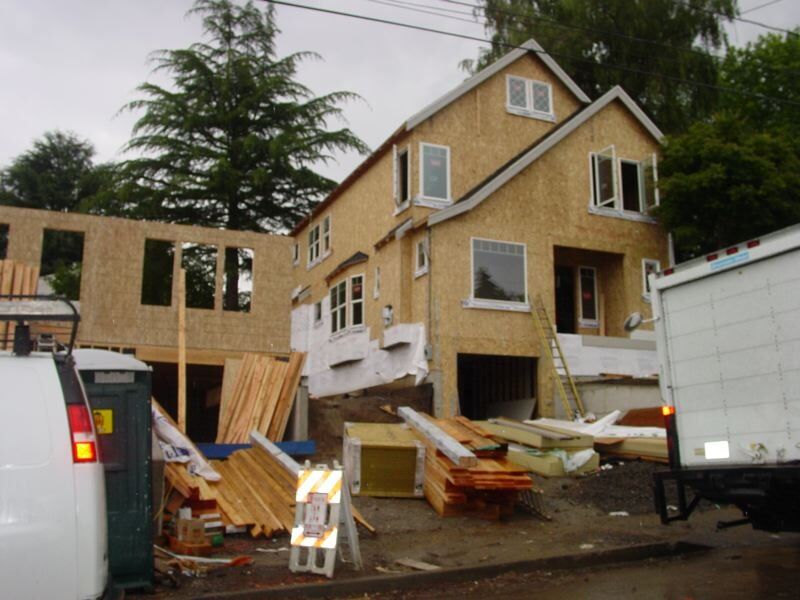Demolitions and new construction dismay Eastmorelanders
Published 12:00 am Wednesday, August 1, 2012

- Two large houses on S.E. Malden in Eastmoreland are being constructed side by side as infill development. This house is three stories tall, with an underground front-entry garage.
Alarmed by new infill construction on properties where vintage houses are being torn down and new houses squeezed onto subdivided lots, the Eastmoreland Neighborhood Association is organizing to prevent such demolitions in the future.
Trending
“I’m really angry,” says Kimberly Koehler, a member of ENA’s Board of Directors. “We shouldn’t have to fight this battle. This issue strikes at the very heart of what is an historic neighborhood.”
Although Eastmoreland is technically not designated “historic”, a portion of the neighborhood is somewhat protected by zoning. From Crystal Springs Boulevard north to Woodstock Boulevard (bordered on the east by S.E. 36th and on the west by Eastmoreland Golf Course), current zoning requires a 25-foot front setback for any new development. And the lots are mostly zoned R5 — for one dwelling unit per 5,000-square-foot lot.
But one third of Eastmoreland (the area east of 36th and south of Crystal Springs Boulevard) lacks that 25-foot front setback protection.
In addition, many of the lots there are historically platted with 25-foot by 100-foot lots — as are many other lots in Southeast Portland. So far, it’s that unprotected Eastmoreland area where developers are demolishing houses in order to build two in the place of one.
“It’s grandfathered in. A fair amount of those lots were platted in the 1920s,” remarks Senior Planner Douglas Hardy, Portland Bureau of Development Services — adding that east of 36th Avenue, Malden, Lambert, Lexington, Nehalem and Flavel Streets are among those with many 25-by-100-foot lots. “Back then, no one imagined someone would build on a lot that size; they were actually platted for an extra side yard.”
But now those lots are enticing developers, who, in some cases, are constructing skinny houses — or, on Southeast Malden Street for example, building large, more expensive houses.
So Koehler, ENA President Robert McCullough, ENA Land-Use Co-Chair Clark Nelson, and Elizabeth Arch met in late June at the Eastmoreland Market to brainstorm strategies to prevent further demolitions of Eastmoreland homes.
“Everyone bought [these homes] on the assumption that 5,000-square-feet meant 5,000-square-feet,” says Arch, who in 1972 moved into her house on S.E. 37th and Glenwood, which is one of the streets where infill construction has occurred.
Examples of the developments that have motivated the group to organize resistance include:
· An early 20th century house at 3651 S.E. Malden, was listed for $359,000 and purchased by a developer who plans to tear it down and construct two new houses.
· Another nearby house on Malden Street has already been demolished and replaced by two new houses (three stories tall, with underground front entry garage), which are currently under construction, with about 10-foot front setbacks and 5-foot side setbacks which are allowed, because this area is not covered by the 25-foot front setback rule.
Developers seem to be targeting Malden Street, and theyre not going to get away with it, Koehler frowns.
But it’s not just Malden Street in Eastmoreland that could be transformed by new construction, observes Arch. If developers can wiggle around the 25-foot setback, they can do anything they want, she said. In Eastmoreland, they could put condos on the corners.
A flyer sent out by residents entitled Help Stop the Destruction of Eastmoreland charges that since 2003 Eastmoreland zones of R5 and R7 no longer mean that lots have to be 5,000 or 7,000 sq ft. However, according to Hardy, most of Eastmorelands zoning west of 36th Avenue involves the standard 50 x 100-foot lot. Five thousand-square-foot zoning means you could only do one dwelling unit, Hardy explains.
The group tells THE BEE that it hopes residents will rally their collective influence, convince developers to leave Eastmoreland alone, and also to get the City of Portland to rezone the neighborhood, possibly two years down the line, in its Comprehensive Plan.
For now, ENA President McCullough says, “I don’t believe we have any direct legal ability to intervene, but we certainly have moral suasion.”
According to Hardy, concerned residents could try to change the zoning code: “To amend the zoning code would require the Portland City Council to instruct the Bureau of Planning & Sustainability to revise this. The best start would be with City Hall and the Mayor’s Office.”





